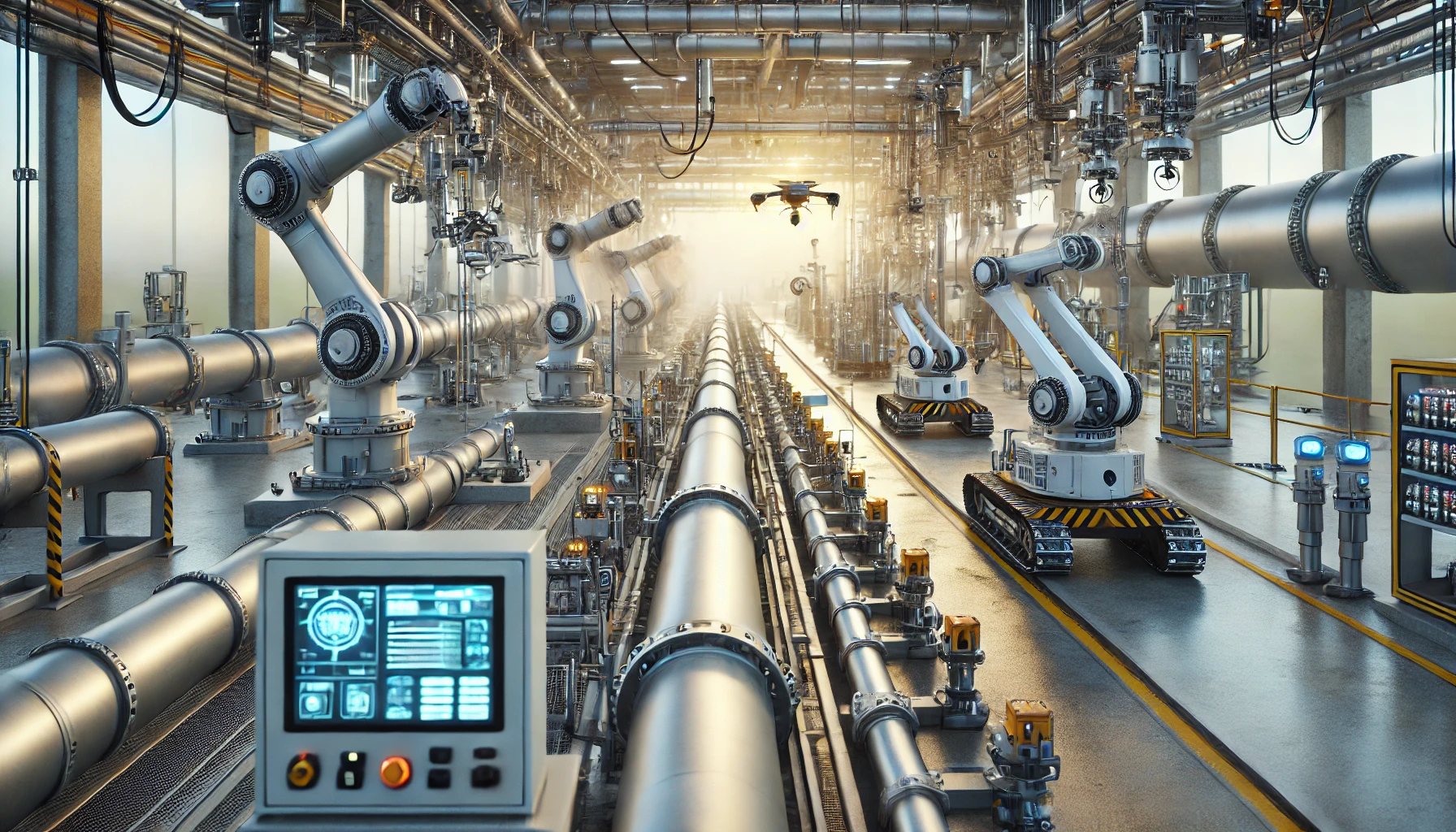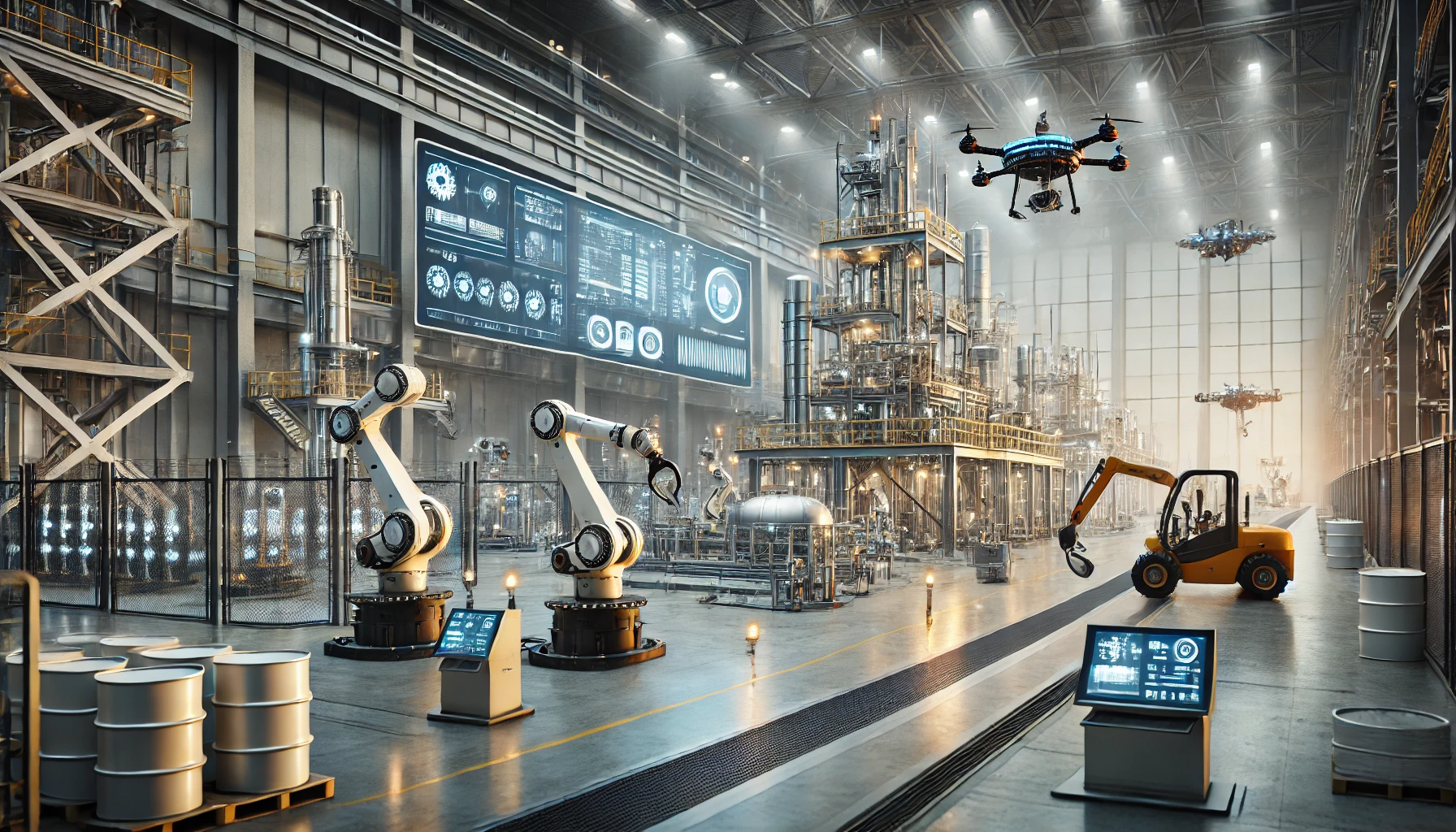As the oil and gas industry continues to face rising operational costs, increased environmental concerns, and the need for improved safety measures, robotics has become a game-changing technology. This technology is transforming the way companies approach complex and hazardous tasks, making operations that were previously unthinkable due to safety and accessibility challenges now possible. From automating dangerous jobs to improving operational efficiency, robotics is redefining the standards of the industry.
In this three-part article, we’ll explore the critical roles robotics is playing in transforming the oil and gas sector, from boosting safety and productivity to integrating AI-driven solutions that provide real-time insights.
Enhancing Safety in Hazardous Environments
The oil and gas industry operates in high-risk environments such as offshore rigs, refineries, and underground drilling sites, which can expose workers to extreme weather conditions, toxic gases, and other hazards. Robotics offers a promising solution by allowing robots to perform tasks in these dangerous areas, reducing human exposure to potential harm and minimizing safety incidents.
Reducing Worker Exposure to Hazards
One of the most significant benefits of robotics in the oil and gas industry is its ability to take on dangerous tasks that would otherwise endanger human workers. Robots equipped with advanced sensors can detect and monitor risks such as gas leaks, fires, and equipment malfunctions without requiring human presence. This capability is especially crucial in offshore platforms and remote drilling sites, where immediate human response can be challenging.
Gas Detection and Fire Suppression: Robots equipped with gas-detection sensors can continuously monitor for gas leaks and fire risks in confined spaces and hard-to-reach areas. They can also activate fire suppression systems or alert emergency response teams if they detect hazardous levels of gas. By detecting leaks early and addressing them promptly, robotic technology helps prevent disasters and reduces the risk of catastrophic incidents.
Inspection of High-Risk Zones: Robots are also essential for routine inspection and maintenance in dangerous environments, such as offshore rigs or areas with high-pressure pipelines. For instance, a robot can be sent to inspect underwater pipelines for damage or corrosion, a task that would be highly risky for human divers. By carrying out these inspections, robots ensure that safety standards are maintained without placing workers in harm’s way.
Supporting Emergency Response
Beyond routine inspections, robotics plays a vital role in emergency situations, providing critical support to mitigate hazards and prevent accidents. Robotic systems are now being designed to respond quickly to emergencies, assisting with evacuation protocols, fire suppression, and hazardous material containment.
Quick Response Capabilities: Robots can be stationed at strategic points across oil rigs and refineries to respond to accidents immediately. In the event of a gas leak or equipment failure, robots can assess the situation in real-time, transmitting data to control rooms and enabling faster decision-making. This rapid response capability significantly reduces the likelihood of escalation, allowing for controlled containment and safety management.
Remote Monitoring for Emergency Situations: During a critical event, remote-controlled robots can be deployed to assess damage and relay information back to the control center. For example, a robot could enter a collapsed structure or fire zone to check for survivors or evaluate structural integrity. By using robots for remote monitoring, oil companies can quickly evaluate dangerous situations without risking the lives of emergency responders.
Advancements in Robotic Safety Technology
The development of more sophisticated safety-focused robotic technologies has further enhanced the role of robotics in protecting workers in the oil and gas industry. Recent advancements include robotics systems that incorporate artificial intelligence (AI) and machine learning to analyze environmental data and predict potential hazards before they occur.
AI-Driven Hazard Prediction: Robots with AI capabilities can analyze patterns and environmental data to identify potential safety hazards. For example, a robot that monitors pipeline vibrations can use predictive analytics to detect unusual vibrations, which may indicate a potential rupture. By identifying these warning signs early, companies can take preventive measures to avoid accidents.
Autonomous Navigation in Hazardous Zones: Many robotic systems are now equipped with advanced navigation algorithms that allow them to move through challenging environments independently. These autonomous robots can navigate obstacles, detect hazardous materials, and avoid high-risk areas, making them ideal for operations in confined or hazardous spaces where human access is limited.
Real-World Examples: Robots Enhancing Safety in Oil Operations
Numerous examples illustrate the effectiveness of robotics in improving safety in the oil and gas sector. For instance, Chevron employs robotic “crawlers” for pipeline inspections, reducing the need for workers to enter potentially dangerous confined spaces. Similarly, BP uses autonomous robots for routine inspections of high-risk zones on offshore platforms, ensuring that safety protocols are maintained without human intervention.
In these scenarios, robotics has proven its value as a transformative tool for enhancing workplace safety. By reducing human exposure to hazards, supporting emergency response efforts, and enabling predictive hazard detection, robotics is paving the way for safer operations in one of the world’s most challenging industries.

Boosting Operational Efficiency and Reducing Costs
As the oil and gas industry becomes increasingly competitive, companies are under pressure to maximize efficiency, reduce costs, and improve productivity. Robotics plays a vital role in meeting these demands, enabling faster, more accurate operations with less reliance on human labor. From automating repetitive tasks to ensuring 24/7 operational continuity, robotics is reshaping the efficiency landscape of oil and gas production.
Automation of Repetitive and Labor-Intensive Tasks
The oil and gas industry involves numerous repetitive and physically demanding tasks, such as drilling, equipment maintenance, and pipeline inspections. Traditionally, these tasks required a substantial workforce, were prone to human error, and often resulted in slowdowns due to worker fatigue. Robots, however, excel at repetitive tasks and bring a level of consistency and accuracy that is difficult to achieve with human labor alone.
Drilling Automation: Robotic drilling systems are becoming increasingly common in oil and gas operations. These robots are capable of performing precise drilling operations without breaks or shifts, drastically reducing the time required to complete drilling projects. Automated drilling robots can also work under extreme conditions, minimizing downtime and improving productivity. By reducing human involvement, companies also lower the risks associated with these hazardous tasks.
Logistics and Supply Chain Management: Robotics is also used in managing logistics within oil fields and processing plants. Automated robots can transport equipment, move materials, and even deliver tools to remote sites. By automating these tasks, companies streamline logistics and improve operational flow, enabling faster delivery and setup of critical resources. This integration also minimizes human intervention in dangerous areas, making the workflow safer and more efficient.
24/7 Operations for Continuous Productivity
One of the key advantages of using robots in oil and gas operations is their ability to function continuously without fatigue or the need for breaks. Robots can operate around the clock, unlike human workers who require rest and shift changes. This capability is invaluable in high-demand environments where maintaining constant productivity is essential for meeting production targets and optimizing resource use.
Increased Output and Efficiency: With robots operating 24/7, oil and gas companies can maintain a steady production rate, improving output without increasing labor costs. For instance, a robotic system used for pipeline inspection can continuously monitor for leaks, wear, and tear, ensuring that maintenance is carried out promptly. This nonstop productivity also allows companies to respond to demand fluctuations with greater flexibility, as robots can easily adapt to changes in workload requirements.
Minimized Downtime: Robots equipped with predictive maintenance capabilities can detect and address equipment issues before they escalate, reducing the likelihood of unexpected breakdowns that disrupt operations. By using robots for real-time monitoring, companies can schedule maintenance during planned downtimes, thereby minimizing production losses. This predictive capability is essential for oil and gas operations where unexpected downtime can lead to substantial financial setbacks.
Cost Reduction Through Predictive Maintenance and Labor Optimization
In addition to boosting productivity, robotics in oil and gas also contributes significantly to cost reduction. By implementing predictive maintenance and optimizing labor allocation, companies can minimize expenses associated with repairs, labor, and operational downtime.
Predictive Maintenance: Predictive maintenance, powered by robotic sensors and AI-driven analytics, has become a cornerstone of cost reduction in oil and gas operations. Robots with sensors continuously monitor equipment conditions, detecting early signs of wear, misalignment, or potential failure. By identifying these issues before they become major problems, companies can schedule repairs proactively, preventing costly breakdowns and extending the lifespan of equipment. This approach not only saves money on emergency repairs but also reduces the frequency of equipment replacements.
Labor Optimization: Robotics enables companies to redirect human labor toward more strategic and complex tasks, as robots take over repetitive, labor-intensive duties. By reallocating skilled workers to focus on higher-value responsibilities, companies can optimize their workforce without increasing headcount. This shift reduces overall labor costs while enhancing the skill utilization and productivity of human employees, creating a more balanced and efficient workforce structure.
Real-World Impact: How Robotics Enhances Efficiency in Oil and Gas
Several companies in the oil and gas industry have successfully integrated robotics into their operations to improve efficiency and reduce costs. For instance, Equinor, a Norwegian energy company, uses robotic systems for offshore drilling, minimizing labor requirements and allowing for continuous operation in remote, harsh environments. Similarly, Saudi Aramco has implemented robotic solutions for pipeline monitoring, reducing maintenance costs and ensuring that its extensive pipeline network remains operational with minimal downtime.
Through these examples, the real-world impact of robotics becomes clear. By automating repetitive tasks, enabling around-the-clock operations, and supporting predictive maintenance, robotics offers substantial operational advantages for oil and gas companies. This efficiency boost is crucial as companies face growing demands for cost-effective solutions in an industry known for its high expenses.
Integration with Advanced Technologies – The Future of Robotics in Oil and Gas
As robotics technology evolves, its role in the oil and gas industry is becoming increasingly sophisticated. Beyond automation and efficiency, robots are now being enhanced with cutting-edge technologies like artificial intelligence (AI), the Internet of Things (IoT), and advanced data analytics. These technologies allow robots to perform more complex tasks, adapt to changing environments, and make autonomous decisions based on real-time data. In this final section, we explore how these advanced integrations are shaping the future of robotics in the oil and gas sector.
AI and Machine Learning: Smarter, More Adaptive Robots
The integration of AI and machine learning has allowed robots to evolve from task-specific machines into intelligent systems capable of analyzing data, learning from patterns, and optimizing their own performance. In the oil and gas industry, this evolution is unlocking new possibilities for automation and operational efficiency.
Predictive Analytics and Decision-Making: Robots equipped with AI can analyze vast amounts of data from equipment, geological surveys, and environmental sensors to identify patterns and predict issues before they occur. For example, an AI-enabled robotic system used for drilling can analyze soil conditions, predict drilling resistance, and adjust its drilling strategy in real-time to optimize performance. By predicting potential challenges and adapting accordingly, robots make oil and gas operations more resilient and less prone to costly setbacks.
Self-Optimizing Operations: With machine learning algorithms, robots can improve their own performance over time by learning from operational data. For instance, a robot used in pipeline monitoring can learn to recognize patterns associated with corrosion or wear, allowing it to adjust inspection parameters based on past observations. This adaptability reduces the need for constant human oversight and enables robots to optimize their functionality for specific tasks or environments.
Real-Time Response to Environmental Changes: AI also allows robots to respond dynamically to environmental changes. For example, robots deployed in underwater operations can adjust their movement and monitoring techniques in response to fluctuations in water pressure or salinity. This capability is particularly valuable in challenging environments where conditions can shift unexpectedly, as it allows robots to complete tasks safely and efficiently.
IoT and Connectivity: Enhanced Monitoring and Data Sharing
The Internet of Things (IoT) has created a network of interconnected devices and sensors that can communicate and share data in real-time. In oil and gas, IoT integration with robotics enables more effective monitoring, data collection, and collaboration across entire production sites. This networked approach allows for enhanced oversight, quicker response times, and improved safety protocols.
Real-Time Data Collection and Analysis: IoT-enabled robots continuously collect data from their surroundings, feeding it into centralized systems that can process and analyze information instantly. This data includes metrics on temperature, pressure, structural integrity, and equipment status, providing operators with a comprehensive view of operations. For example, an IoT-connected robot on an offshore platform can relay temperature fluctuations to an onshore control center, allowing engineers to make immediate adjustments.
Remote Monitoring and Control: IoT connectivity allows for remote monitoring and control of robots across long distances. Operators can monitor and direct robotic operations from command centers, eliminating the need for human presence in high-risk areas. In emergency situations, such as a gas leak, operators can remotely direct robots to assess and contain the situation, reducing the need to expose personnel to hazardous conditions.
Seamless Collaboration Between Machines and Workers: IoT integration also supports collaborative work environments, where robots and human workers can share data seamlessly. By accessing real-time data, human workers can make more informed decisions and coordinate more effectively with robotic systems. This collaborative approach ensures that workers and robots complement each other’s strengths, enhancing overall operational efficiency and safety.
Diverse Applications of Advanced Robotics
The incorporation of AI, IoT, and other advanced technologies is expanding the range of applications for robotics in the oil and gas industry. From aerial drones for remote inspections to autonomous underwater vehicles (AUVs) for subsea operations, robots are now being deployed in a variety of roles, each optimized to perform specific tasks that are challenging for human workers.
Drones and UAVs for Aerial Inspections: Drones are increasingly used for aerial inspections of onshore and offshore facilities. Equipped with high-definition cameras and sensors, drones can survey vast oil fields, inspect flare stacks, and monitor environmental compliance. They provide a cost-effective, quick, and safe alternative to traditional inspection methods, eliminating the need for human workers to climb structures or use scaffolding.
Autonomous Underwater Vehicles (AUVs) for Subsea Operations: In underwater oil and gas facilities, AUVs are employed for complex subsea inspections, maintenance, and monitoring tasks. These robots can navigate deep underwater, inspecting pipelines, detecting leaks, and analyzing the seabed. By using AUVs, companies can maintain and monitor offshore infrastructure without the need for human divers, reducing both risk and cost.
Robotic Arms and Manipulators for Precision Tasks: Robotic arms equipped with advanced sensors are used in operations that require high levels of precision, such as valve adjustments, welding, and equipment assembly. These manipulators can be controlled remotely or programmed for specific tasks, allowing for accuracy and consistency. In offshore environments, robotic arms provide invaluable support by performing repairs or adjustments in areas that are challenging for human workers to access.
Sustainability: Robotics Supporting Environmental Goals
As the oil and gas industry faces increasing pressure to adopt sustainable practices, robotics plays a key role in helping companies meet environmental goals. By reducing waste, minimizing emissions, and optimizing resource use, robotic systems support the industry’s transition toward greener operations.
Reducing Environmental Impact Through Precision Operations: Robots equipped with precision tools and sensors minimize the environmental impact of oil and gas extraction. For example, robots used in drilling can optimize the use of drilling fluids and reduce emissions associated with flaring. By performing tasks with higher accuracy, robots help minimize waste and prevent unnecessary environmental damage.
Monitoring and Managing Environmental Hazards: Robotics systems designed for environmental monitoring can detect and respond to environmental hazards in real-time. Robots equipped with sensors can monitor for air and water quality, ensuring compliance with environmental regulations. For instance, a robot deployed near an oil spill can detect contamination levels and assist in cleanup efforts, reducing the overall impact on the ecosystem.
Supporting the Shift Toward Renewable Energy: As the oil and gas industry increasingly explores renewable energy sources, robotics can facilitate this transition. Robots are already used in the maintenance of solar and wind installations, and their role will expand as more companies invest in renewable energy. By supporting both traditional and renewable operations, robotics helps bridge the gap between current energy demands and future sustainability goals.

Conclusion: Robotics Shaping a Resilient, Sustainable Future for Oil and Gas
The role of robotics in the oil and gas industry is multifaceted, enhancing safety, efficiency, and sustainability across the sector. As companies integrate AI, IoT, and advanced analytics, robotics technology becomes more powerful, adaptive, and capable of performing complex tasks autonomously. By embracing these advancements, the oil and gas industry is not only improving operational performance but also positioning itself for a future where safety, environmental responsibility, and technological innovation are paramount.
The evolution of robotics in oil and gas is a testament to the industry’s commitment to progress and adaptability. By reducing human exposure to hazards, optimizing resource use, and supporting sustainable practices, robotics is setting the stage for a new era in energy production. As technology continues to advance, the role of robotics will only expand, becoming an indispensable part of the oil and gas industry’s journey toward a resilient, safe, and sustainable future.
With robotics at the forefront of these changes, the future of the oil and gas industry looks promising, marked by greater operational resilience, reduced environmental impact, and enhanced safety for workers and communities alike.



